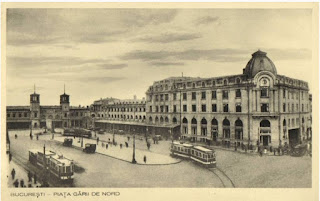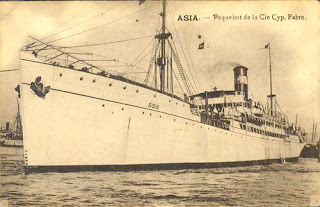 |
| The Fabre Line's S.S. Asia. Undated Postcard |
The Journey
On July 9, 1924, Abram Broitman boarded the S.S. Asia at the Black Sea port of Constanța. Its route for this voyage would take it through the Turkish Straits separating the Black Sea from the Aegean; on to the Mediterranean; through the Strait of Gibraltar to the Atlantic Ocean; and finally, to the deep-water port of Halifax. A mid-sized steamship, owned at that point by the Fabre Line, the S.S. Asia was built in 1907 and could carry over 1,400 passengers. Third-class cabins, which made up the majority of the accommodations, had up to six berths each. The Fabre Line’s advertising noted, in both Yiddish and English, that the Asia boasted “shower baths” and “hygienic lavatories,” and meals would be served in “spacious and elegant dining rooms” by “courteous waiters.” Given the conditions Abram and the refugees had endured for the previous few years, it must have seemed luxurious.
 |
| Fabre Line third-class cabin |
 |
| Fabre Line dining hall Photos from advertisements for the Fabre Line ships S.S. Bagra and S.S. Asia. Images courtesy of the Alex Dworkin Canadian Jewish Archives |
Supporting Jewish Practice on the High Seas
The Jewish Colonization Association had gone to great lengths to ensure that the trip would in fact be as comfortable as possible for the refugees. A 1924 press release stated that Fabre Line ships would provide strictly kosher food for the Jewish emigrants and would carry a “Sepher Thora,” a Torah scroll, with a special room being set aside for use as a sanctuary “on shabbes and festivals.”
While no Jewish holidays fell during the three weeks that Abram was aboard the ship, his voyage included three sabbaths at sea, meaning that three weekly Torah portions were read. One of these was Parashat Balak (Numbers 22:2-25:9), which includes the story of the non-Israelite prophet Balaam (and his talking donkey.) Balaam is hired by King Balak of Moab to curse the Israelites, but finds he is only able to bless them. One can imagine Abram and his fellow refugees reflecting on their circumstances that shabbat morning, and hoping that despite the intentions of those who wanted to harm them, they would find blessing in their new country.
 |
| Press release sent from the Jewish Colonization Association (JCA) in Paris to JIAS. 20 Feb 1924. Alex Dworkin Canadian Jewish Archives. JIAS-CA-26-5441-JCA |
The Missing Passengers
While the S.S. Asia had berths for 1,480 people, it’s possible that the 380 refugees in third class were the only passengers on board. The United States had seen a flood of immigration between 1890 and 1914, but with the outbreak of World War I, all immigration essentially ceased. Immigration increased when the war ended, but the political appetite for new immigrants was very low. By 1924 there were strict quotas for new immigrants in place. In the U.S. these were based on the makeup of the American population in 1890. In Canada the restrictions were less draconian, but still heavily favored Northern and Western Europeans. In both countries, immigration legislation and policy had the purposeful effect of severely restricting the entry of Chinese, Japanese, Italian, and Eastern European would-be émigrés.Next time: Preparations in Canada for the arrival of the S.S. Asia and the newest crop of refugees.







